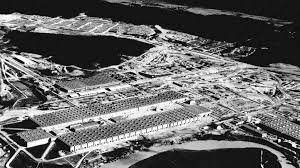On August 26, 1945, the United States witnessed the culmination of the top-secret Manhattan Project, a scientific and engineering endeavor that had been underway since 1939. This ambitious project aimed to develop the world's first atomic bomb, ultimately leading to its successful deployment and the end of World War II. The Manhattan Project was born out of fears that Nazi Germany, under the leadership of Adolf Hitler, might be developing atomic weapons. The project was authorized by President Franklin D. Roosevelt in response to a letter from renowned physicist Albert Einstein, warning of the potential devastating consequences of atomic weapons falling into the wrong hands. Under the leadership of General Leslie R. Groves, the Manhattan Project brought together some of the world's brightest scientific minds, including physicists such as J. Robert Oppenheimer and Enrico Fermi. The project assembled a vast network of research facilities, including the main laboratory in Los Alamos, New Mexico, where the final stages of bomb development took place. The project faced immense challenges, both scientific and practical. Researchers had to overcome numerous technical hurdles to harness the power of nuclear fission and create a controllable chain reaction. Massive amounts of resources, including uranium and plutonium, were required to fuel the bombs. The project also required a significant investment of financial and human capital, with thousands of scientists, engineers, and support staff working diligently to achieve their goal. On July 16, 1945, the Manhattan Project achieved a major breakthrough with the successful test of the first atomic bomb, code-named "Trinity," in the deserts of New Mexico. The detonation of Trinity proved the feasibility of atomic weapons and marked a turning point in human history. Just weeks after the Trinity test, on August 6, 1945, the United States dropped an atomic bomb named "Little Boy" on the Japanese city of Hiroshima. The devastation caused by the bomb was immense, leading to the deaths of an estimated 140,000 people, many of them civilians. Three days later, on August 9, a second atomic bomb, "Fat Man," was dropped on the city of Nagasaki, resulting in the deaths of around 70,000 people. The bombings of Hiroshima and Nagasaki had a profound impact on Japan and the world at large. The immense destruction and loss of life forced Japan to surrender to the Allied forces, effectively bringing an end to World War II. However, the moral and ethical implications of the bombings have been the subject of intense debate ever since. The Manhattan Project's successful development and deployment of atomic weapons marked a turning point in human history. The project ushered in the nuclear age, forever altering the geopolitical landscape and raising concerns about the potential for global annihilation. The atomic bombings of Hiroshima and Nagasaki also served as a stark reminder of the destructive power of nuclear weapons and prompted international efforts to prevent their proliferation.
26 Aug, 1945 U.S.A. Manhattan Project
